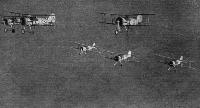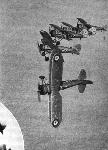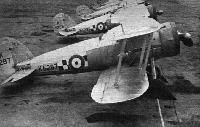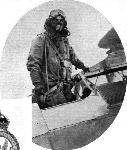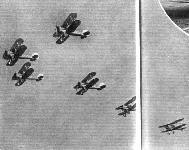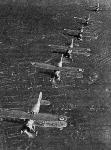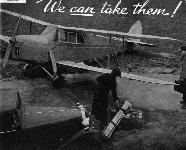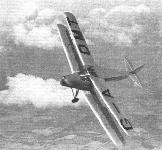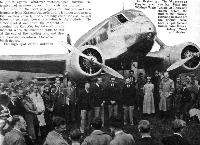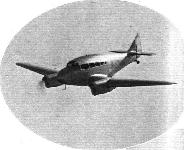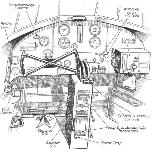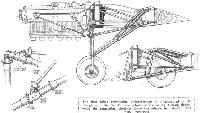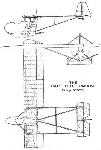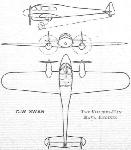Фотографии
-
Регистрационный номер: K7033 One of outstanding military types of 1936: The Bristol Blenheim
Самолёты на фотографии: Bristol Blenheim - Великобритания - 1936
-
Регистрационный номер: K4240 One of outstanding military types of 1936: The Handley Page Hampden.
Самолёты на фотографии: Handley Page Hampden / H.P.52 - Великобритания - 1936
-
Two canons are mounted in fairings below the fuselage of the new Potez 63 three-seater, twin-engined fighter.
Самолёты на фотографии: Potez Potez 63 - Франция - 1936
-
Регистрационный номер: K5054 One of outstanding military types of 1936: The Supermarine Spitfire
Самолёты на фотографии: Supermarine Spitfire - Великобритания - 1936
-
Самолёты на фотографии: Dewoitine D.500 / D.510 - Франция - 1932
-
Регистрационный номер: K4303 APPROACH TO A PROBLEM - 1: This view of the Fairey Battle medium bomber (1,065 h.p. Rolls-Royce Merlin) affords an interesting comparison with the Armstrong Whitworth machine intended for similar duties. Note the revised cockpit enclosure and undercarriage and the D.H. v.p. airscrew.
Самолёты на фотографии: Fairey Battle - Великобритания - 1936
-
General arrangement of the 250 m.p.h. Lockheed Super Electra.
Самолёты на фотографии: Lockheed Electra Junior 12 - США - 1936
-
Регистрационный номер: K6127 "... AND SUCH GREAT NAMES." The Westland Army Co-operation monoplane, now named the Lysander.
Самолёты на фотографии: Westland Lysander - Великобритания - 1936
-
Demonstrative of the field of fire obtainable from a well-arranged multi-seater, this drawing shows the arcs covered by the guns of the French Amiot 144.
Самолёты на фотографии: Amiot Amiot 140 / Amiot 143BN5 - Франция - 1931
-
OUR KING AS PILOT: A photograph taken at Croydon soon after the War of a 504K Avro, at the controls of which was Prince Albert. Incidentally, London's airport was known in those days as "The Government Aerodrome, Waddon."
Самолёты на фотографии: Avro Avro 504 - Великобритания - 1913
-
Showing the installation of a drum-fed machine gun and 20mm. canon in the French Loire 46 fighter.
Самолёты на фотографии: Loire Loire 43/45/46 - Франция - 1932
-
APPOSITE: Christmas greetings from Air Service Training Ltd. at Hamble. The message is formed by white-overalled humanity "on the hands down," and the "A.S.T." consists of the ten different aircraft types which form the organisation's fleet: Avro V, 626, Avian, Tutors and Cadets; two-seater Siskin; A.W. Atlas; two Cutty Sarks; and D.H. Leopard Moth and Hornet Moth.
Самолёты на фотографии: Armstrong Whitworth Atlas / Ajax - Великобритания - 1925Armstrong Whitworth Siskin - Великобритания - 1921Avro Avian / Type 594/616 - Великобритания - 1926Avro Cadet / Type 631/643 - Великобритания - 1932Avro Five / Type 619 / Six / Type 624 - Великобритания - 1929Avro Tutor/Sea Tutor/Prefect / Type 621/646/626 - Великобритания - 1929De Havilland Hornet Moth / D.H.87 - Великобритания - 1934De Havilland Leopard Moth / D.H.85 - Великобритания - 1933Saunders-Roe Cutty Sark / A.17 - Великобритания - 1929
-
Регистрационный номер: K4549 CLOUD-WALKING: An Overstrand of No. 101 (Bomber) Squadron inspects the silver lining.
Самолёты на фотографии: Boulton Paul Overstrand / P.75 - Великобритания - 1933
-
An excellent view of the nose portion of the Fokker G.I twin-engined attack machine, showing the installation of the canons and machine guns.
Самолёты на фотографии: Fokker G.I Le Faucheur - Нидерланды - 1937
-
JUNKERS FOR THE NORTH: A batch of Junkers Ju.86 bombers have been ordered by the Swedish Government. The first machine was recently demonstrated at Bromma, near Stockholm, by Captain Soederberg. It is likely that the production machines will be fitted with Swedish-built Pegasus engines, or Mercuries as they are called in Sweden, for some baffling reason.
Самолёты на фотографии: Junkers Ju.86 - Германия - 1934
-
In battle formation: Six Gauntlets up on patrol, searching the skies for the raiding bombers.
Самолёты на фотографии: Gloster Gauntlet - Великобритания - 1929
-
Dive bombing: From echelon on the right, the leader cartwheels down for an attack on a ground target.
Самолёты на фотографии: Gloster Gauntlet - Великобритания - 1929
-
Регистрационный номер: K5287 [2], K5288 [3], K5289 The red and white diced pattern is the distinguishing mark of No. 56 (Fighter) Squadron, still as efficient a body as it was in the days of Ball and McCudden.
Самолёты на фотографии: Gloster Gauntlet - Великобритания - 1929
-
A pilot is shown wearing his R/T and oxygen apparatus.
Самолёты на фотографии: Gloster Gauntlet - Великобритания - 1929
-
Регистрационный номер: K5287 [2], K5288 [3] No. 56 Squadron to-day: At the alarm the pilots run to their machines and clamber into their seats.
Самолёты на фотографии: Gloster Gauntlet - Великобритания - 1929
-
Регистрационный номер: K5288 [3] Not exactly the velvet gloves, for one can see the Gloster Gauntlets though one cannot see the Bristol Mercury engines inside the cowlings. All pilots love the Gauntlet, and will be sorry when the day comes for reequipment.
Самолёты на фотографии: Gloster Gauntlet - Великобритания - 1929
-
Самолёты на фотографии: Gloster Gauntlet - Великобритания - 1929
-
A little fancy flying: No. 56 F.S. shows that it can fly in line astern
Самолёты на фотографии: Gloster Gauntlet - Великобритания - 1929
-
PROTOTYPE II. The Fairey light reconnaissance seaplane intended for operation from warships. A Napier Rapier VI moderately supercharged engine is fitted.
Самолёты на фотографии: Fairey Seafox - Великобритания - 1936
-
This Power boat had fell designs on the defences of our East Coast, but the Anson spotted her and reported her position to H.Q. at Manston.
Самолёты на фотографии: Avro Anson / Type 652 - Великобритания - 1935
-
Coastal reconnaissance aircraft normally wish to see and not to hide themselves, but sometimes they practise navigation above the cloud banks
Самолёты на фотографии: Avro Anson / Type 652 - Великобритания - 1935
-
Регистрационный номер: K6158, K6173 Some of the Avro Ansons (two Siddeley Cheetahs IX) of No. 48 (General Reconnaissance) Squadron at Manston.
Самолёты на фотографии: Avro Anson / Type 652 - Великобритания - 1935
-
FIRST IN SERVICE: This view shows to advantage the installation of a moderately supercharged Bristol Perseus sleeve-valve engine in a Vickers Vildebeest torpedo-bomber. This combination has been adopted by the Air Ministry and marks the entry of sleeve-valve engines into the Service
Самолёты на фотографии: Vickers Vildebeest / Type 132 - Великобритания - 1928
-
CHRISTMAS RUSH: A tarmac impression at Croydon on December 24. Beneath the port wing of the Swissair Douglas can be seen an Air France Wibault, an H.P. 42, Scylla and Syrinx, while behind the Douglas is a Railway Air Services' D.H.86.
Самолёты на фотографии: De Havilland Express Air Liner / D.H.86 - Великобритания - 1934Douglas DC-1 / DC-2 / C-32 / C-39 - США - 1933Handley Page H.P.42 / H.P.45 - Великобритания - 1930Short Scylla / L.17 - Великобритания - 1934Wibault Wibault 280 - Франция - 1930
-
Such clean and pleasing lines as these of the Chilton monoplane are seldom found in the "ultra-light category."
Самолёты на фотографии: Chilton D.W.1 - Великобритания - 1937
-
Регистрационный номер: G-ADIS Самолёты на фотографии: De Havilland Hornet Moth / D.H.87 - Великобритания - 1934
-
Регистрационный номер: G-ADMT SOCIABILITY AND SAFETY: This unusual flying picture of the D.H. Hornet Moth reflects credit on the pilots both of the D.H. 87B (the official designation of the Hornet) and of the machine which carried Flight's photographer. Incidentally, its price has just been reduced to ?775 - a figure which is distinctly reasonable for a side-by-side cabin machine of this type. With a normal range of 600 miles and possessing excellent "small field" capabilities on full load, the Hornet, though not exceptionally fast (it cruises at 105 m.p.h. or a little less), is a really useful private owner's aeroplane. Its eood take-off gives it possibilities as a floatplane and at least one machine has been successfully flying in this guise over in Canada.
Самолёты на фотографии: De Havilland Hornet Moth / D.H.87 - Великобритания - 1934
-
KEEPING ITS END UP: A small parachute is sometimes carried in the tail of a machine as a precautionary measure during spinning tests. This view shows such an installation on a Heston Phoenix.
Самолёты на фотографии: Heston Phoenix - Великобритания - 1935
-
The Luton Minor (34 h.p. British Anzani)
Самолёты на фотографии: Luton Minor - Великобритания - 1937
-
Регистрационный номер: G-ADHL The Empire boat (four 758/815 h.p. Pegasus X Cs).
Самолёты на фотографии: Short Empire / S.23 - Великобритания - 1936
-
Регистрационный номер: G-ADHM The long-range Short boat, Caledonia, moored off Hythe, Southampton. After the necessary fuel consumption and other tests have been carried out this boat will be flown to Foynes for a series of experimental crossings to Botwood, Newfoundland.
Самолёты на фотографии: Short Empire / S.23 - Великобритания - 1936
-
Регистрационный номер: G-ADUU BERMUDA RIGGED. The hull of Cavalier, the Short Empire flying boat which will operate in conjunction with a machine of Pan-American Airways on the Bermuda - New York service, being hoisted, in what is said to be the world's largest packing case, aboard the S.S. Loch Katrine. The case follows the lines of the hull remarkably closely; if the bottom corners were "gouged" out the resemblance would be even more striking.
Самолёты на фотографии: Short Empire / S.23 - Великобритания - 1936
-
ANOTHER INVADER: The agency for this machine, the American Porterfield 70, has been obtained by Surrey Flying Services. With a 70 h.p. Le Blond engine this tandem-seater cabin monoplane cruises at 105 m.p.h. and will cost ?625 over here.
Самолёты на фотографии: Porterfield 35 Flyabout - США - 1936
-
The new Mureaux 190 light single-seater fighter mounts a Salmson inverted vee-twelve engine arranged to accommodate a canon firing through its airscrew boss, which is raised accordingly.
Самолёты на фотографии: ANF Mureaux Mureaux 190 - Франция - 1936
-
The only really large commercial aeroplane in the Show, the Farman 224 carries 40 passengers and a crew of four. In the foreground is the Mureaux 190 C.1 fighter.
The Farman 224 monoplane - developed from the Centaur used over the South Atlantic. It is probable that one of these machines will be the first to make Air France's contribution to the experimental work.Самолёты на фотографии: ANF Mureaux Mureaux 190 - Франция - 1936Farman/SNCAC NC.224 - Франция - 1937
-
The Mureax 190 fighter, says Maj. Bulman, puts a good case for the in-line engine (a 450 h.p. 12 cyl. Salmson, with canon).
Самолёты на фотографии: ANF Mureaux Mureaux 190 - Франция - 1936
-
Регистрационный номер: NC14715 FAR EASTERN TERMINUS: The Manila-Hongkong section of Pan-American Airways' Pacific service was covered for the first time at the end of October with Mr. Juan Trippe and nineteen passengers. In due course, Imperial Airways' Penang - Hongkong and Atlantic services will be used to carry passengers as well as mail and the Anglo-American girdle will be complete. Here is the Martin Philippine Clipper arriving at Hongkong.
Самолёты на фотографии: Martin China Clipper / Type 130 - США - 1934
-
Регистрационный номер: G-EBVG The Calcutta (three 525 h.p. geared Bristol Jupiters)
Самолёты на фотографии: Short Calcutta / Rangoon / S.8 - Великобритания - 1928
-
The Dart Kitten (25 h.p. Ava)
Самолёты на фотографии: Dart Kitten - Великобритания - 1937
-
THE SEA-DOUGLAS: The new Douglas DF flying-boat has, since a photograph was originally reproduced in Flight, been put through its paces and appears to have performed well. The machine is, of course, of all-metal construction and an interesting departure from normal Douglas practice is the use of skin corrugations in the wing covering, which, incidentally, is fabric aft of the rear spar. The recess into which the wing-float partially retracts can be seen in this view.
Самолёты на фотографии: Douglas DF - США - 1936
-
HEAT BLISTERS: The defensive armament of this Boeing YB-17 bomber, the first of thirteen for the U.S. Army Air Corps, is carried in a novel nose turret and four streamlined blister-like emplacements whence, so it is said, "the heat can be turned on" in practically all directions. The YB-17 is the largest landplane ever built in the U.S.A. and represents a class which has not so far featured in our own expansion programme. Four of the new Wright Cyclone "G" engines are fitted and a retractable undercarriage and tail wheel, flaps, v.p. airscrews, homing equipment, two-way R/T and an automatic pilot are specified.
Самолёты на фотографии: Boeing B-17 Flying Fortress - США - 1935
-
Регистрационный номер: G-AECB [2] The Beginning: The Monospar Croydon (two 400 h.p. Pratt and Whitney Wasp Juniors) at Hanworth shortly before the start of the journey. Standing in front are the original crew, Lord Sempill (second from left) and Messrs. Gilroy, Wood and Davies.
Самолёты на фотографии: General Aircraft Monospar ST-18 Croydon - Великобритания - 1935
-
Регистрационный номер: G-AECB [2] The pilot, Mr. Wood, about to "abandon ship" on the coral reef.
Самолёты на фотографии: General Aircraft Monospar ST-18 Croydon - Великобритания - 1935
-
The tapering line of cabin windows is one of the features which give ths Peregrine such an attractive external appearance.
Самолёты на фотографии: Miles Peregrine / M.8 - Великобритания - 1936
-
INHERITED CLEANLINESS. The Miles Peregrine light transport monoplane bears, from many angles, a marked resemblance to the Falcon. With two Gipsy Six IIs the maximum speed with a 2,200 lb. disposable load is 180 m.p.h. Menasco Buccaneer B.6S engines, supercharged to 4,500 ft give an improvement of 14 m.p.h.
Самолёты на фотографии: Miles Peregrine / M.8 - Великобритания - 1936
-
A commendable feature of the Peregrine's cockpit layout is the central pillar housing the mere important controls and indicators.
Самолёты на фотографии: Miles Peregrine / M.8 - Великобритания - 1936
-
A flush exterior is preserved on the Peregrine by a special design of concealed door handle illustrated by these sketches.
Самолёты на фотографии: Miles Peregrine / M.8 - Великобритания - 1936
-
The first Miles retractable undercarriage is incorporated in the Peregrine. On the left are details of the safety locking device, while the remaining sketches show the wheels in "down" and "up" positions.
Самолёты на фотографии: Miles Peregrine / M.8 - Великобритания - 1936
-
The fine proportions of the Peregrine, despite its roomy cabin, are brought out in these G.A. drawings.
Самолёты на фотографии: Miles Peregrine / M.8 - Великобритания - 1936
-
Регистрационный номер: K4299 [2] PROTOTYPE I. The new Armstrong Whitworth P. 27/32 medium bomber with Siddeley Tiger VIII fourteen-cylinder engine. The turret is of Armstrong Whitworth design.
Самолёты на фотографии: Armstrong Whitworth A.W.29 - Великобритания - 1936
-
Регистрационный номер: K4299 [2] APPROACH TO A PROBLEM II: Built to Air Ministry specification P.27/32 this new Armstrong Whitworth monoplane has a Tiger VIII fourteen-cylinder radial with two-speed supercharger driving a D.H. variable-pitch airscrew.
Самолёты на фотографии: Armstrong Whitworth A.W.29 - Великобритания - 1936
-
Регистрационный номер: G-ADUA ULTRA-LIGHT LUXURY: A totally enclosed and exhaust-heated cockpit has been designed for a special Kronfeld Drone recently produced to the order of a private owner, Mr. R. Dimock. It will be noticed that this machine also has a rubber-sprung split-axle undercarriage and the latest exhaust system. Mr. Dimock will not be likely to lose his hat again, (as once happened, with catastrophic results) while flying this machine.
Самолёты на фотографии: Kronfeld Drone - Великобритания - 1932
-
Регистрационный номер: G-AEKU UNDERGRADUATION: Mr Kronfeld taxies his new "flying" ground trainer at Hanworth while the latest type of Carden-engined Drone De Luxe flies overhead. The standard De Luxe model costs L325, while the ground trainer is priced at L195. The Country Flying Club, of Leicester, charge 9s. an hour for instruction on the normal ground trainer which they have been using successfully for the past month or two.
Самолёты на фотографии: Kronfeld Drone - Великобритания - 1932
-
Регистрационный номер: G-ABFA [2] The Kent (four 555 h.p. geared Jupiters)
Самолёты на фотографии: Short Kent / S.17 - Великобритания - 1931
-
Регистрационный номер: G-ABFA [2] The Kent (four 555 h.p. geared Jupiters)
Самолёты на фотографии: Short Kent / S.17 - Великобритания - 1931
-
Two of the Marcel Blochs used by Regie Air Afrique on their African service. The photograph was taken at Elizabethville while the machines were being refuelled, one to continue towards Europe and the other towards Madagascar.
Самолёты на фотографии: Bloch MB.60 / MB.120 - Франция - 1930
-
Регистрационный номер: G-AEOG The new Hordern-Richmond "Autoplane" over Goodwood House, residence of the Duke of Richmond and Gordon.
Самолёты на фотографии: Hordern-Richmond Autoplane - Великобритания - 1936
-
The Dart Flittermouse (25 h.p. Scott)
Самолёты на фотографии: Dart Flittermouse - Великобритания - 1936
-
Регистрационный номер: G-AEMA It is likely that the rear fuselage portion of the Cygnet will be simplified in production. This view shows the component for the prototype
Самолёты на фотографии: C.W. Aircraft Cygnet - Великобритания - 1937
-
Самолёты на фотографии: C.W. Aircraft Cygnet - Великобритания - 1937
-
The two main Flight sketches show the salient internal and external features and the remainder indicate structural methods.
Самолёты на фотографии: C.W. Aircraft Cygnet - Великобритания - 1937
-
The basic construction of the monocoque fuselage is founded on built-up frames and "Z" section stringers..
Самолёты на фотографии: C.W. Aircraft Cygnet - Великобритания - 1937
-
C-W Cygnet Minor Cirrus Minor Engine
Самолёты на фотографии: C.W. Aircraft Cygnet - Великобритания - 1937
-
C-W Swan Two Villiers-Hay Maya Engines
Самолёты на фотографии: C.W. Aircraft Swan - Великобритания - 1937
Статьи
- Flight
- Flight Advertisements















